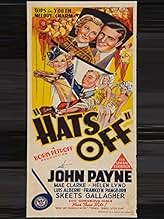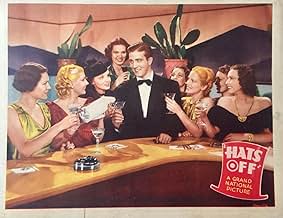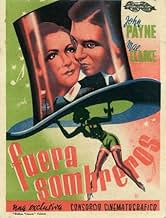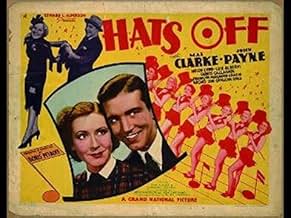VALUTAZIONE IMDb
5,3/10
201
LA TUA VALUTAZIONE
Aggiungi una trama nella tua linguaRival press agents Jimmy Maxwell and Jo Allen have both been assigned to stir up publicity for separate exhibitions at the 1936 Texas Centennial.Rival press agents Jimmy Maxwell and Jo Allen have both been assigned to stir up publicity for separate exhibitions at the 1936 Texas Centennial.Rival press agents Jimmy Maxwell and Jo Allen have both been assigned to stir up publicity for separate exhibitions at the 1936 Texas Centennial.
- Regia
- Sceneggiatura
- Star
Richard 'Skeets' Gallagher
- Buzz Morton
- (as Skeets Gallagher)
Franklin Pangborn
- Mr. Churchill
- (as Franklyn Pangborn)
The Radio Rogues
- Comic Trio
- (as The Three Radio Rogues)
Phil Bloom
- Cornerman
- (non citato nei titoli originali)
Ralph Brooks
- Nightclub Patron
- (non citato nei titoli originali)
Wheaton Chambers
- Board Member
- (non citato nei titoli originali)
Recensioni in evidenza
I was wondering why John Payne looked like and acted like Jimmy Stewart in this movie. I think it was because 1936 was Stewart's break out year. He starred in four movies and had good parts in four more. His career was exploding. Somebody probably saw Payne and figured people would think he was Stewart. Payne never quite reached Stewart's level of super-stardom, but he seemed to have a greater acting range, playing tough guys as easily as sweetheart roles. Here, he is quite affable and charming. One wishes he had more screen time. This is also Sam Fuller's first screenplay. I am not that familiar with Fuller's corpus except for some of his major works - "The Big Red One," "Shock Corridor" "The Naked Kiss" and "Pick Up on South Street." This seems quite different from the other works that I've seen by him, much lighter in tone. Mae Clarke is dull and Helen Lynn does seem to be doing a Gracie Allen imitation. Only Luis Alberni as Rosero hits the right notes to brighten the film a bit. The other characters are not given enough screen time to make a solid impression. This is just passable and I think only John Payne fans would really be interested enough to watch the whole thing.
I can only hope that there are still Americans like those in this film in today,s USA. The movie gives us one hour of light popular musical enjoyment. John Payne as usual presents a very likable and professional acting performance. Mae Clarke is pretty and charming and I have fond memories of her in other films. Franklin Pangborne contributes his unique comedy talents. It is good to visit a past era when fine human qualities of USA life were presented to the world via the Movies and universally admired.. Of course, much that was unpleasant was rarely shown but at least we can take a break from the worries of modern life and just relax and enjoy one hour of escape.
This is a bit of an odd curio, in the fact that this is looks to be an attempted at a high-polished musical by a low rent studio. The Results are mixed here. Some of the songs are rather low rent.. I mean, the Twinkle Twinkle bit is nothing short of stupid, and the final number is just plain boring, but the boxing number and the bar sequence are fun, though implausible (How can a boxing match be commentated by a sextet?) The story is screams 1930s, about dueling fairs in nearby cities, and their attempts to outdo each other. John Payne and Mae Clarke play the publicists of the two fairs, and they try to outdo each other, and try to hire the famous show creator Bosero. Naturally, skulduggery follows. Mae Clarke is okay I suppose, and John Payne plays his Jimmy Stewart imitation quite well, What somewhat fails them is the potholes in the script, like there are incredible leaps in comprehension, how exactly was the Texas tycoon convinced to go to the bar in the first place? Who exactly was Bosero putting the show on for? And since the lead singer / dancer quit, well, what happened then? This is a movie that you really, REALLY have to squint in order to enjoy, and just keep a loose head as possible, because if you think to much about the comprehensiveness of this, your head will explode.
Minor attempt to duplicate the worldwide sensations of the Rogers-Astaire musicals at RKO, "Hats Off" was made by a Poverty Row studio that lasted only three or four years, Grand National. They even managed to bring in a couple of the second bananas from Ginger's movies, Luis Alberni (Roberta) and Franklin Pangborn (Professional Sweetheart, Flying Down to Rio); this pair of actors was to reappear the following year in the excellent "Easy Living."
"Hats Off" suffers greatly from a simple lack of money; the props are no match for the legendary Great White Sets that RKO was producing for their musicals; the lighting and camera work are not up to any major studio's standards; the editing is... well, poverty level; they clearly didn't pay a lot for the script; and the music is less than stellar. Is it a great movie no but it's a lot of fun and a good example of 1930s filmmaking by a minor studio.
According to a much later interview with her early roommate Barbara Stanwyck, Mae Clarke was actually a fine dancer, but there's no attempt to bring her talent to the screen here. John Payne is great in a very early role - his hair cream splendor reminds one sharply of the style that was still popular when Elvis Presley was using it 20 years later.
"Hats Off" suffers greatly from a simple lack of money; the props are no match for the legendary Great White Sets that RKO was producing for their musicals; the lighting and camera work are not up to any major studio's standards; the editing is... well, poverty level; they clearly didn't pay a lot for the script; and the music is less than stellar. Is it a great movie no but it's a lot of fun and a good example of 1930s filmmaking by a minor studio.
According to a much later interview with her early roommate Barbara Stanwyck, Mae Clarke was actually a fine dancer, but there's no attempt to bring her talent to the screen here. John Payne is great in a very early role - his hair cream splendor reminds one sharply of the style that was still popular when Elvis Presley was using it 20 years later.
A couple of cities which sound an awful lot like Dallas and Fort Worth in real life take their rivalry quite seriously. Both are planning big expositions wanting to be chosen as the site of a planned World's Fair.
John Payne plays the organizer for the show of one of the cities and Mae Clarke is sent in to spy on him for the other. Of course the inevitable happens, need I go any farther.
The songs are provided by the team of Ben Oakland and Herbert Magdison and one of them, Twinkle Twinkle Little Star did enjoy some minor success during the time.
This was Payne's second feature film and first lead after being spotted in a minor role in Dodsworth. He'd have to wait for a few years before hitting the big time with 20th Century Fox.
Maybe this might have faired better at a major studio, but this was Grand National Pictures. As it is it's pleasant enough entertainment but nothing spectacular.
John Payne plays the organizer for the show of one of the cities and Mae Clarke is sent in to spy on him for the other. Of course the inevitable happens, need I go any farther.
The songs are provided by the team of Ben Oakland and Herbert Magdison and one of them, Twinkle Twinkle Little Star did enjoy some minor success during the time.
This was Payne's second feature film and first lead after being spotted in a minor role in Dodsworth. He'd have to wait for a few years before hitting the big time with 20th Century Fox.
Maybe this might have faired better at a major studio, but this was Grand National Pictures. As it is it's pleasant enough entertainment but nothing spectacular.
Lo sapevi?
- QuizThis film received its initial USA telecast Sunday 22 February 1942 on New York City's pioneer television station WNBT (Channel 1). On the West Coast its earliest documented telecast took place in Los Angeles Monday 10 March 1947 on Don Lee's still experimental W6XAO (Channel 2); its next airings were in New York City Sunday 18 September 1949 on WPIX (Channel 11), in Cincinnati Thursday 8 December 1949 on WKRC (Channel 11), and in Chicago Saturday 8 April 1950 on WBKB (Channel 4).
I più visti
Accedi per valutare e creare un elenco di titoli salvati per ottenere consigli personalizzati
Dettagli
- Data di uscita
- Paese di origine
- Lingua
- Celebre anche come
- Hats Off
- Luoghi delle riprese
- Azienda produttrice
- Vedi altri crediti dell’azienda su IMDbPro
- Tempo di esecuzione1 ora 6 minuti
- Colore
- Proporzioni
- 1.37 : 1
Contribuisci a questa pagina
Suggerisci una modifica o aggiungi i contenuti mancanti

Divario superiore
By what name was Cappelli in aria (1936) officially released in India in English?
Rispondi


















